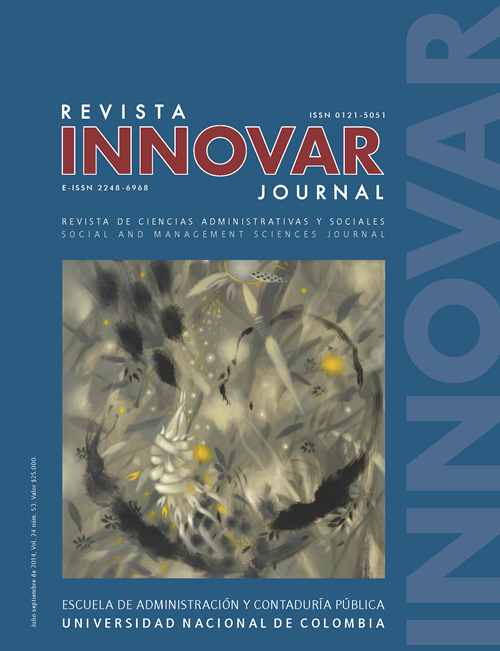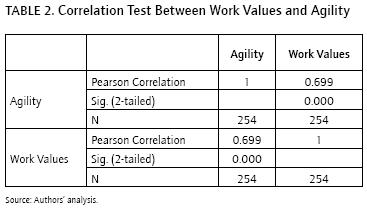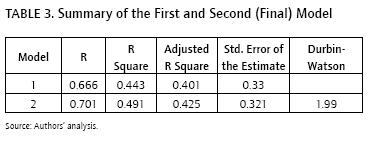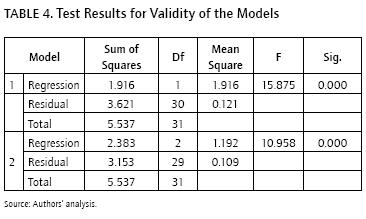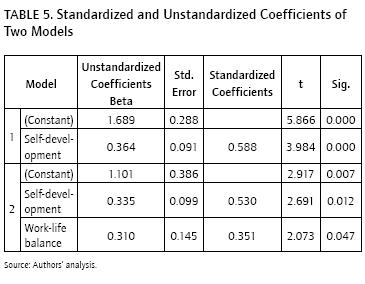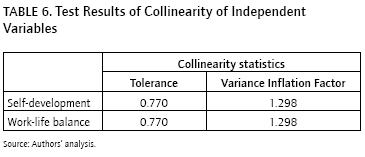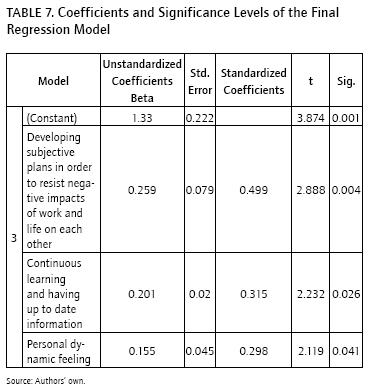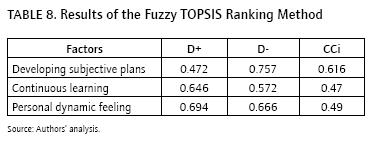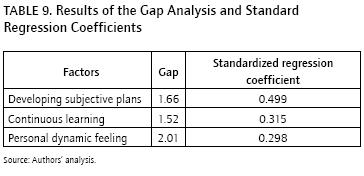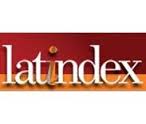Agility Path Through Work Values in Knowledge-Based Organizations: A Study of Virtual Universities
Camino a la agilidad a través de los valores laborales en organizaciones basadas en el conocimiento: un estudio de las universidades virtuales
Rumo à Agilidade através dos valores Trabalhistas Em ORGANIZAÇÕES baseadas no conhecimento: um estudo das universidades virtuais
DOI:
https://doi.org/10.15446/innovar.v24n53.43942Palabras clave:
Agility, Work values, organizational Agility, virtual Universities, Iran (en)agilidad, valores laborales, agilidad organizacional, universidades virtuales, Irán (es)
agilidade, valores trabalhistas, agilidade organizacional, universidades virtuais, Irã (pt)
Descargas
Agility Path Through Work Values in Knowledge-Based Organizations: A Study of Virtual Universities
Camino a la agilidad a través de los valores laborales en organizaciones basadas en el conocimiento: un estudio de las universidades virtuales
Vers une agilité au travers de valeurs professionnelles dans des organisations basées sur la connaissance: une étude des universités virtuelles.
Rumo à Agilidade através dos valores Trabalhistas Em ORGANIZAÇÕES baseadas no conhecimento: um estudo das universidades virtuais
Yashar SalamzadehI, Mehran NejatiII, Aidin SalamzadehIII
I Higher education Center, department of Management, Payam noor University, Tehran, Iran. E-mail: yasharsalamzadeh@gmail.com
II Post-doctoral Fellow. Graduate school of Business, Universiti Sains Malaysia (USM), Penang, Malaysia. E-mail: mehran@usm.my
III University of Tehran, Tehran, Iran. E-mail: salamzadeh@ut.ac.ir
Correspondencia Dt Mehran Nejati, 31-06-06, Lakeside Towers, Tingkat Bukit Jambul 1, Bayan Lepas 11900, Penang, Malaysia.
Citación: Salmzadeh, Y, Nejati, M. & Salamzadeh, A. (2014). Agility Path through Work values in Knowledge-based organizations: A study of virtual Universities. Innovar, 24(53), 177-186.
Clasificación JEL: M 10, M 14, D83.
Recibido: Agosto 2011; Aprobado: noviembre 2013.
Abstract:
All people enter organizations with a formed personality and some initial experiences and values depending on the culture, which will, in turn, influence their efficiency and performance. therefore, great attention must be paid to work values of the employees and the issues which affect them, especially in organizations that are complex in their structure and culture. Today's dynamic environment requires organizations to be agile in their processes, with the issue being even more critical in knowledge-based organizations such as virtual universities. in this research, we identify the path through which organizations can achieve agility by means of work values. Although there are many dimensions in work values and organizational agility, using the methodology applied in this research, we omit some of these dimensions and find the best methods that will enable managers to wisely invest in the most important issues and get the best results in the path to achieve agility through work values.
Keywords: Agility, Work values, organizational Agility, virtual Universities, Iran.
Resumen:
Todas las personas ingresan a las organizaciones con una personalidad formada y con algunas experiencias y valores iniciales que dependen de la cultura, y que influencian su eficiencia y desempeño. Por lo tanto, es necesario prestar mucha atención a los valores laborales de los empleados y a los factores que los afectan, en especial en organizaciones complejas en cuanto a su estructura y cultura. El ambiente dinámico de hoy en día requiere que las organizaciones sean ágiles en sus procesos, y esto es incluso más crítico en organizaciones basadas en el conocimiento como las universidades virtuales. En esta investigación, identificamos el camino mediante el cual las organizaciones pueden alcanzar la agilidad por medio de los valores laborales. si bien existen muchas dimensiones de los valores laborales y de la agilidad organizacional, al usar la metodología que aplicamos a esta investigación, omitimos algunas de estas dimensiones y encontramos la mejor manera en la que los gerentes pueden invertir inteligentemente en las cuestiones más importantes, y así obtener los mejores resultados en el camino de lograr la agilidad mediante valores laborales.
Palabras clave: Agilidad, valores laborales, agilidad organizacional, universidades virtuales, Irán.
Résumé:
Toutes les personnes intègrent les organisations avec une personnalité formée et avec certaines expériences et valeurs initiales qui dépendent de la culture et qui influencent leur efficience et leur rendement. Par conséquent, il est nécessaire de faire très attention aux valeurs professionnelles des employés et aux facteurs qui les affectent, en particulier dans des organisations complexes quant à leur structure et à leur culture. Le contexte dynamique d'aujourd'hui requiert que les organisations soient agiles dans leurs processus, et cela est encore plus vrai dans les organisations basées sur la connaissance comme les universités virtuelles. Dans cette investigation, nous avons identifié la manière dont les organisations peuvent parvenir à cette agilité par l'intermédiaire de valeurs professionnelles. Bien qu'existent de nombreuses dimensions des valeurs professionnelles et de l'agilité organisationnelle, en utilisant la méthodologie que nous appliquons pour cette recherche, nous avons laissé de côté certains de ces aspects et nous avons trouvé la meilleure manière dont les gérants peuvent investir intelligemment dans les questions plus importantes, et obtenir ainsi les meilleurs résultats en vue d'atteindre l'agilité par le biais de valeurs professionnelles.
Mots-clés: Agilité, valeurs professionnelles; agilité organisationnelle; universités virtuelles; Iran.
Resumo:
Todas as pessoas chegam às organizações com uma personalidade formada e com algumas experiências e valores iniciais que dependem da cultura e que influenciam a sua eficiência e desempenho. Portanto, é necessário prestar muita atenção aos valores trabalhistas dos empregados e aos fatores que os afetam, especialmente em organizações complexas quanto a sua estrutura e cultura. O ambiente dinâmico de hoje requer que as organizações sejam ágeis em seus processos e isto é até mesmo mais crítico em organizações baseadas no conhecimento como as universidades virtuais. Nesta pesquisa, identificamos o caminho mediante o qual as organizações podem atingir a agilidade mediante os valores trabalhistas. Embora existam muitas dimensões dos valores trabalhistas e da agilidade organizacional, ao usar a metodologia que aplicamos a esta pesquisa, omitimos algumas destas dimensões e encontramos a melhor maneira para que os gerentes possam investir inteligentemente nos assuntos mais importantes e obter os melhores resultados no objetivo de chegar à agilidade mediante valores trabalhistas.
Palavras-chave: agilidade, valores trabalhistas, agilidade organizacional, universidades virtuais, Irã.
Introduction
Nowadays a great awareness and appreciation of differences in work values and cultures from different viewpoints including personal and organizational perspectives has led to increased attention being paid to their influence (Soontiens & De Jager, 2008). We know that in our modern dynamic lifestyles, everyone belongs simultaneously to a number of groups and categories of people in society. So everyone inevitably carries several different layers of values within themselves (Iguisi, 2009, p. 144). Culture and, to a lesser degree, work values make people act and behave differently in organizations and society and these differences can be caused by many variables such as different personal goals, expectations, experiences and views about work values. these differences build a great field of study for human resource managers and scholars all around the world to investigate the methods of effective management of organizations and people of different cultures and lead to the improvement of both. Although many explanations have been presented by scholars in the field of culture (Barrett, Jones & McEvoy, 1996; Ram & Jones, 1998; Wilson & Portes, 1980), as Knocke (2000) mentions, most of the time, the underlying source of these differences in the way people act and behave in different environments is still unknown. Also, many organizations around the world try to grow and compete with their competitors through, one of the most common ways to do so, organizational agility. Organizations deal with constant changes in the business environment, which requires them to be agile in coping with constant changes. While change is not something new, current changes are occurring at a speed beyond the control of many organizations, causing turbulence and uncertainty in the business environment to be a major cause of failure in organizations (Yaghoubi, Kazemi, Dahmardeh & Arhami, 2011). Agility increases the ability of the organization to provide high quality products and services and is therefore critical for increasing the competitive ability of the organization (Crocitto & Yusuf, 2003).
Sharifi and Zhang (2001) introduced agility as a two-part phenomena, including responding to changes properly and exploiting changes and taking advantage of emerging changes as vital opportunities to grow and compete better. The most famous categories to analyze the agility of an organization belong to Sharifi and Zhang (1999) and include: Responsiveness, Competency, Coincidence and Flexibility, and Quickness.
Many companies have embraced the notion that to operate effectively in today's economy, it is necessary to become a knowledge-based organization (Itami, 1987). Given that intellectual capital is considered as a key competitive advantage in the knowledge economy, people management should naturally become an integral part of corporate strategy and a key responsibility of all managers (Thite, 2004). Given the importance of the agility to stay competitive and adapt to changes, agility is arguably one of the most important characteristics of successful organizations coping with the ever-increasing demands of today's world. Employee power has to be used when it comes to attempting to achieve organizational agility. This is where work values come into play. if we identify the agility path through work values, many of the behavioral needs for agility will become clear. This will allow easier decision making for achieving organizational agility. Thus, identifying the path for organizations to achieve agility through work values is essential for organizational competitiveness.
Review of Literature
Work Values
Values are subjective entities and there is a great range of discussion on them in value related literature (Hofstede, 1980; Rokeach, 1973; Schwartz, 1994). One of the best thematic definitions of values belongs to Rokeach (1973), defining value as "an enduring belief that a specific mode of conduct or end state of existence is personally or socially preferable to an opposition or converse mode of conduct or end state of existence". Schwartz (1994, cited by song & Gale, 2008) presents that there is a great agreement in value literature on five contributing features in definition of values.
Value is a belief, related to desired end states or modes of conduct, which overrides specific situations, guides in selecting and evaluating a known behavior, people and events and is usually ordered by relative importance against other values to form a complex system of value priorities. Here, we focus on a part of human values, namely work values, which can be defined as the importance individuals in organizations give to outcomes of their work context (Elizur, 1984). As mentioned by Ros, schwartz and Surkiss, (1999), work values according to the theory of basic human values are specific and personal expressions of individuals' values in the work setting of their organization.
There are three main streams of research on work values including its structure, its correlation to personal, social and/or organizational variables, and finally from the viewpoint of cultural factors (Sagie, Elizur, & Koslowsky, 1996). There are many definitions and assessment tools about work values, but as many scholars argue, Super's Work values inventory (super, 1970) is clearly the favorite and most common instrument for assessing work values (Jennifer & Gareth, 1997). Super (1970) explained work values as a part of people's personal values that can be satisfied by work.
Similar to the study by Nejati, Salamzadeh and Sharafi, (2010) on work values in Iran, the current study examined five dimensions of work values, consisting of Making Contributions, interpersonal Harmony, Work-life Balance, self-development and finally Job satisfaction.
Agility
There are many different definitions for agility, but here we will emphasize on its concept more than its definitions. Agility started from production management field (Iacocca Institute, 1991a; 1991b) and then became prominent in the service field. As mentioned by Swafford, Ghosh, and Murthy, (2006), agility enables an organization to respond to environmental uncertainties and market volatility in a timely and effective fashion, allowing organizations to be able to establish a superior competitive position in their field of activity. There is, as yet, no universal definition available for agility and many scholars have discussed the ignored dimensions in different definitions of agility. For example, Li, Chung, Goldsby, and Holsapple, (2008) discussed the missed dimensions in report by the Global logistics Research Team at Michigan State University in 1995 and there are a lot of these examples in agility related literature.

There are many different views on agility. As Sam-Bamurthy, Bharadwaj and Grover, (2003) explain, agility is comprised of three interrelated capabilities, namely customer agility, partnering agility and operational agility. Besides, there are also some emphases on knowledge in agility related literature. For example, Naylor, Nairn, and Berry, (1999) express that Agility is "using market knowledge and a virtual corporation to exploit profitable opportunities in volatile marketplace". Overall, research into how practitioners view knowledge management and how they are developing and implementing strategies and programs is scarce (Chase, 1997).
A virtual organization is one where the core business processes are performed by using electronic media such as Internet. More specifically, a virtual university refers to a university, which offers higher education programs through electronic media, typically the Internet. As argued by Ca-Marinha-Matos et al. (2000), agility is an important requirement for successful organizations in periods of market turbulence and unpredictable socio-economic changes, and the concept of virtual enterprise embeds an implicit notion of agility in itself. Zhang and Sharifi (2000) believe that agility constitutes of three factors: 1 -agility drivers, which refer to changes and pressures of organization's environment that makes it necessary to search for new ways of running a business in order to maintain or achieve competitive advantage; 2-agility capabilities, which are the essential capabilities that are needed in order to respond to changes and take advantage of them; and 3-agility providers, which are the means through which an organizations can obtain capabilities.
Sharifi and Zhang (1999, 2001) identified dynamic competitive pressure as one of the most important drivers of agility in any organization. Vázquez-Bustelo, Avella and Fernández, (2007) believe that turbulent environments influence agility. Besides, Yusuf and Adeleye (2002) viewed agility as a response to emerging requirements of sophisticated and changing consumers and products under persistently changing competitive and success factors.
In this way, we can recognize the importance of agility and becoming agile in all organizations, especially in knowledge-based organizations, which undertake their activities in a dynamic and changing environment.
Methodology and Research Construction
As mentioned before, this research intends to propose a path to agility through work values. This started with an in-depth study of agility and work values. The results of these studies were a list of important dimensions extracted from these two fields. Simultaneously, we gathered the information about all virtual universities in Iran, which were the focus of our study. Since most of the relevant researches in the field of agility belong to the production field, we were forced to undertake interviews with professionals from both fields and then conduct a content analysis on these interviews to obtain practical and customized dimensions and sub-dimensions of agility and work values. Then we examined the validity of the obtained research constructs by carrying out some more in-depth interviews with scholars, whereby some changes were made to the questionnaire. Then, we distributed the questionnaires in the sample of virtual universities and asked their top managers and decision makers and lecturers to complete the questionnaire. In order to ensure the adequacy of the sample, we calculated the sample size using 3 methods (ranging from 223 to 260) and distributed the questionnaires pertaining to the biggest number attained. A total of 270 questionnaires were distributed, with a return rate of 94 percent.
In the next step, we analyzed the relationship between work values and agility by regression analysis. Then, we tested the more important dimensions, which resulted from the regression analysis using appropriate tests.
In the last step, the agility path through work values was identified. To this end, the influential factors of work values on agility were identified using two criteria, namely importance and the present situation. After performing standard regression and gap analysis with the ideal situation, the agility paths were ranked using fuzzy TOPSIS technique. In this way a simple path to agility through work values has been investigated and proposed. Some suggestions according to the results have also been made at the end.
Research Constructs
After a review of the literature on agility and work values and conducting some interviews, we decided to use the following dimensions for each of these issues. The sub-dimensions introduced for each dimension were the result of interviews combined with the related literature review.
As for work values, we used the same dimensions as Nejati et al. (2010) study on work values in Iran, including the following five factors: Making Contributions, Job Satisfaction, Interpersonal Harmony, Self-development and Work-life Balance.
In the agility dimension, we used the ideas of Sharifi and Zhang (1999) and applied the following dimensions: Responsiveness, Competency, Coincidence and Flexibility, and Quickness.
In this research, we used fuzzy TOPSIS as a ranking method. Below, a short explanation of this method is provided.
Fuzzy TOPSIS
Fuzzy TOPSIS is a methodology that extends TOPSIS for decision making to cases conducted in uncertain and fuzzy environments; thus, providing the ability to deal with the uncertainty of human judgments in evaluating the importance of a certain issue (Salamzadeh, Saeida Ardakani & Zanjirchi, 2009).
The numerical value of each linguistic term used in our questionnaire, was determined based on the following rule (see table 1), using a fuzzy approach.
As mentioned by Kahraman, Cebeci and Ruan, (2004), there are two important characteristics of fuzzy systems that give them better performance for many different applications:
(1) Fuzzy systems are suitable for uncertain or approximate reasoning, and we know that these kinds of situations exist in the management field; and.
(2) Fuzzy logic allows decision-making with estimated values under incomplete or uncertain information that can be seen quite often in the management field also.
We used a fuzzy TOPSIS approach, similar to the methodology applied in the study by Nejati et al. (2009) for ranking service quality factors in the airline industry. The required steps of fuzzy TOPSIS undertaken in the current study are explained below.
Step One
Consider a fuzzy decision matrix of respondents' ideas as follows, where i stands for the number of factors (quality factors) and j stands for the number of respondents.
Also, X ij stands for the score assigned by respondent number i for factor j. On the other hand, W∼ij is the importance (weight) of each respondent's ideas. It must be added that, because all the respondents are considered to have the same weight, W∼ij will be defined
As

Step Two
This step includes neutralizing the weight of the decision matrix and generating fuzzy un-weighted matrix (R∼). To generate R∼ either of the following relations can be applied.

Where

Where

Step Three
This step includes generating fuzzy un-weighted matrix V∼, while having W∼ij as an input for the algorithm:

Step Four
Determine positive ideal (FPIS, A+) and negative ideal (FPIS, AJ) for the factors:

In this research, the positive and negative ideas introduced by Chen (2000) are used. Therefore:

Step Five
In this step, we calculate the sum of distances from positive and negative ideas for each factor. For fuzzy numbers such as A and B, the difference between A and B shown as D (A, B) is determined using the following formula:

Therefore, the difference of each factor from positive and negative ideals is calculated:

Step Six
The adjacency of each factor to positive ideal is calculated as the following:

Step Seven
This is the final step where we rank factors in a descending order of CCi, meaning that the higher CCi are at the top.
Research Findings and Results
First Level of Analysis: regression Analysis of Agility Based on work Values
Dimensions
As mentioned earlier, in order to identify the gap from the ideal situation, firstly we calculated the mentioned gap for all agility dimensions using the formula formula (Since we used a 5-point likert spectrum, the ideal situation has been assumed to be 5):
Gapi = 5-Scorei
Then, we entered the gaps in a mean test to recognize the deviation and, in this way, we tested the hypothesis below:
H0: µ = 0
H1: µ # 0
We undertook this test for agility and then repeated it for four agility dimensions and then for all variables in each dimension. We found that none of the results show a zero deviation from the ideal situation and so we can say that all of the dimensions need to be improved. The next step was to recognize the agility path through work values. Because all parameters in this research had a normal distribution, we used parametric statistics.
Firstly we examined the relationship between agility and work values by using a Pearson test. The results are shown in Table 2.
Results show that agility and work values have a positive relationship. Thus, if a path to agility could be established through through work values, this could lead to a great competitive advantage for the organization helping it to shift toward excellence. But investment in all aspects of work values is not rational. Thus, we have to identify the most important dimensions, which lead to agility. So conducting a regression analysis will be a good choice here.
It is suggested that before a regression analysis, it is necessary to recognize the linear relationship between variables, which is usually undertaken using scatter plots. Here in our study, there was a significant linear relationship between two dimensions of work values (namely self-development and work-life balance) with agility, but we decided not to omit the other dimensions in this phase because firstly their relationship was nearly linear, and, secondly, it is common for some variables to be omitted in the regression analysis process. Here, we used a multiple regression model with a step-by-step approach. In the first step, the "self-development" dimension was introduced into the model and, in the second step, the "work-life balance" dimension was added to the last dimension. The other dimensions did not enter the model. The Table 3 shows a summary of the regression model.
As we can see, R Square in the first model is equal to 0.44 and in the second model increases to a better position and equals to 0.49 which proves that almost half of the agility changes in Iranian virtual universities stem from the two mentioned dimensions of the work values.
According to the above results, we can say that if a knowledge-based organization, especially a virtual university, emphasizes on self development and work-life balance-the two most important dimensions of work values-it can more easily achieve an agile organizational profile. It is clear that work-life balance makes a proper context for self development and it will render human resources more agile, providing a clear path to achieving organizational agility.
Next, we conducted a validity test on our model, with the results summarized in the table 4.
Low significance levels show that our model has a good fitness. This good fitness provides additional support through a statistical approach for identifying and accepting the two dimensions as the most affective ones.
In the next step, the final multiple regression model using unstandardized coefficients and standardized coefficients (beta coefficient) according to the table 5, will be presented.
Here is the regression model using unstandardized coefficients:
Agility = 1.101+0.335 (self-development) +0.310 (work-life balance)
And the regression model using standardized coefficients is as below:
Agility= 0.53 (self-development) + 0.351(work-life balance)
In the above equation, it is clear that even between these two dimensions, the self-development dimension which is the behavioral part of the equation plays a more important role compared to the contextual dimension (work-life balance), as it has a higher regression weight. Thus, in cases where the contextual dimension is not good enough to facilitate agility, still an agile manner in organization can be achieved through working on the behavioral dimension (self-development).
After presenting these models, we examined the residuals and according to their aggregation around the diagonal line we can say that distribution of residuals is a normal distribution. Then, we analyzed the diagram of standardized residuals against standardized predicted values in order to analyze variance of the dependent variable, and the results again showed the fitness of our model.
We also examined the independence of all observations using Durbin-Watson test on the residuals and as showed before the result was near 2 (exactly 1.99) that shows no correlation between consecutive data.
On the other hand, we examined the collinearity between independent variables using tolerance and Variance Inflation Factor. As we know, values of more than 0.1 for tolerance and less than 10 for variance inflation factor show that there is no problem with the fitness of the regression model. Following is the result of this test on our regression model (see table 6).
Having undertaken these tests, we can claim that our regression model fits the issue, and that the two dimensions of self-development and work-life balance are the most important dimensions of work values that help to achieve organizational agility. Testing the model using different approaches and achieving a confirmed fitness in all of them, makes working with the model easier. Thus, the proposed model can be used by other researchers in future in a similar context, with a higher reliability and less concern over the fitness of the model.
Second Level of Analysis: Regression Analysis of important dimensions of work Values (self-development and work-Life Balance)
So far, we have seen the most influential dimensions of work values that enable virtual universities to be agile. However, in order to do some operational planning, we have to become more precise about these two important dimensions. Therefore, we repeated the prescribed procedure for 10 sub-dimensions of these two main dimensions and after developing three models (the same as 2 models in the last part), we found that three sub-dimensions of those two important main dimensions (Self-Development and Work-Life Balance) have a great role in achieving agility in virtual universities.
In work-life balance dimension from the four existing subdimensions, one entered the last regression model (namely, "developing subjective plans in order to resist negative impacts of work and life on each other").
In the other dimension (self-development), from the six existing sub-dimensions, two entered the last regression model (namely, "continuous learning and having up to date information" and "personal dynamic feeling").
As mentioned earlier, we conducted three models and here we only propose the last one. This regression model has an R Square equal to 0.68 and results of F-test showed a good fitness for the model. The coefficients and significance levels of the regression model are shown in the table 7.
Regression model of these sub-dimensions is as follows:
Agility = 0.499 (developing subjective plans) + 0.315 (continuous learning) + 0.298 (personal dynamic feeling).
The above equation clearly shows the way to achieve an agile profile. Planning for improvement, developing new approaches and changing the organizational climate to be agile is easily available through the above factors and their weight shows their importance and effect in terms of becoming an agile organization.
In order to check the validity and fitness of this model, we undertook a procedure like the last model in the level one of the study. Firstly, by using a scatter plot, we found that residuals have a normal distribution. Then we calculated the Durbin-Watson coefficient, which was equal to 1.99 and the variance inflation factor was also near 1, meaning that there was no collinearity between variables.
In the next step, we ranked these three sub-dimensions using fuzzy TOPSIS to present a clear view of them. Following is the result of our analysis using fuzzy TOPSIS (see table 8).
The table 8 shows that according to TOPSIS analysis, the most important factor for achieving agility is developing subjective plans. This finding confirms the results of the regression analysis. As we can see, there is a change of order between the second and third factors compared to the regression model. Nonetheless, both methods indicate that factors 2 and 3 are really close to each other in terms of weight and difference from the ideal choice. Below are the results of the gap analysis and standardized regression coefficients (see table 9).
Gap analysis is an addition to the current case study and it cannot be expanded it to other researchers' cases. However, it is suggested that researchers and practitioners apply the similar analysis to get a better perspective of their organization in the future. We found that the biggest gap exists in the "personal dynamic feeling" dimension and the best situation relates to "continuous learning". Hence, policy makers and executives can now plan to make improvements in order to make this gap smaller. They can plan to change some cultural issues, run new systems, develop new approaches or change some work flows within their span of power.
Conclusion
Today, there are many models and concepts that try to facilitate the movement of organizations toward excellence and fitness. But a new problem in this environment is that no manager can invest all his/her resources on all models and methods, so there is a need for organizations to find the best methods to achieve the required results under different circumstances.
In this study, we chose agility as the face of an organization. By showing a positive relationship between agility and work values, we highlighted the importance of considering work values and started to find the agility path through work values. In order to choose the best method, we examined all five dimensions of work values and found that only two of them (Self-Development and Work-Life Balance) had the highest impact on agility, which indicated a potential agility path. By testing these two dimensions, we identified three sub-dimensions, namely developing subjective plans, continuous learning, and personal dynamic feeling, which were the most important ones in impacting agility and, finally, we ranked them from two points of view.
Organizations, regardless of sector, are turning to agility and agile practices to maintain competitiveness. Agility has been identified as a key element in the science of competitiveness, allowing organizations to ride atop environmental mega-waves such as virtual organizations (Holsapple & Jin, 2007; Li et al., 2008). Thus, agility can be used as the secret weapon for virtual organizations to successfully cope with the challenging environment and be flexible in responding to demand changes (Stank, Daugherty & Ellinger, 1996; Van Hoek, Harrison & Christopher, 2001).
Since the concept of agility is still ambiguous, and researchers are still at the stage of defining factors or determinants of agility (Giachetti, Martinez, Sáenz & Chen, 2003), the findings of the current study provides invaluable addition to literature through identifying the agility path in a virtual organization. Another contribution of this research is the chosen methodology, which can be used by managers and scholars for different issues. Here, we emphasized on work values and looked at the organization from a human resource management perspective. The output of this research helps managers to conduct and hold some executive plans that enable them to achieve agility in their organizations.
References
Barrett, G.A., Jones, T.P., & McEvoy, D. (1996). Ethnic minority business: theoretical discourse in Britain and North America. Urban Studies, 33(4-5), 783-809.
Camarinha-Matos, L. M., Afsarmanesh, H., & Rabelo, R. J. (2000). Supporting agility in virtual enterprises. E-Business and Virtual Enterprises, (pp. 89-104).
Chase, R. L. (1997). The knowledge-based organization: an international survey. Journal of Knowledge Management, 1(1), 38-49.
Chen, C.T. (2000). Extensions of the TOPSIS for group decision-making under fuzzy environment. Fuzzy sets and systems, 114(1), 1-9.
Crocitto, M., & Youssef, M. (2003). The human side of organizational agility, Industrial Management & Data Systems, 103(6), 388-397.
Elizur, D. (1984). Facets of work values: a structural analysis of work outcomes. Journal of Applied Psychology, 69(3), 379-89.
Giachetti, R. E., Martinez, L. D., Sáenz, O. A., & Chen, C. S. (2003). Analysis of the structural measures of flexibility and agility using a measurement theoretical framework. International Journal of Production Economics, 86(1), 47-62.
Hofstede, G. (1980). Culture's Consequences: International Differences in Work-related Values. London, Sage.
Holsapple, C. W., & Jin, H. (2007). Connecting some dots: E-commerce, supply chains, and collaborative decision making. Decision Line, 38(5), 14-21.
Iacocca Institute (1991a). 21st Century Manufacturing Enterprise Strategy (Vol. 1). Lehigh University, Bethlehem, PA.
Iacocca Institute (1991b), 21st Century Manufacturing Enterprise Strategy (Vol. 2). Lehigh University, Bethlehem, PA.
Iguisi, O. (2009). Motivation-related values across cultures. African Journal of Business Management, 3(4), 141-150.
Itami, H. (1987). Mobilizing Invisible Assets, Cambridge, Massachusetts: Harvard University Press.
Jennifer, M.G., & Gareth, R.J. (1997). Experiencing work: Values, attitudes, and moods. Human Relations, 50(4), 393-416.
Kahraman, C., Cebeci, U., & Ruan, D. (2004). Multi-attribute comparison of catering service companies using fuzzy AHP: The case of Turkey, International Journal of Production Economics, 87, 171-184.
Knocke, W. (2000). Integration or segregation? Immigrant populations facing labour market in Sweden. Economics and Industrial Demography, 21 (3), 361-80.
Li, X., Chung, C., Goldsby, T., & Holsapple, C. (2008). A unified model of supply chain agility: the work-design perspective. International Journal of Logistics Management, 19(3), 408-35.
Lin, C. T., Chiu, H., & Chu, P. Y. (2006). Agility index in the supply chain. International Journal of Production Economics, 100(2), 285-299.
Naylor, J.B., Naim, M.M., & Berry, D. (1999). Leagility: Integrating the lean and agile Manufacturing paradigms in the total supply chain. International Journal of Production Economics, 62(1/2), 107-18.
Nejati, M., Nejati, M., & Shafaei, A. (2009). Ranking airlines' service quality factors using a fuzzy approach: Study of the Iranian society. International Journal of Quality and Reliability Management, 26(3), 247-260.
Nejati, M., Salamzadeh, Y., & Sharafi, F. (2010). Work values in Iranian context. Technics Technologies Education Management (TTEM), 5(1), 166-177.
Ram, M., & Jones, T. (1998). Ethnic Minority, Small Business Research Trust, Milton Keynes.
Rokeach, M. (1973). The Nature of Human Values. The Free Press, New York, NY.
Ros, M., Schwartz, S.H., & Surkiss, S. (1999). Basic individual values, work values, and the meaning of work. Applied Psychology: An International Review, 48(1), 49-71.
Sagie, A., Elizur, D., & Koslowsky, M. (1996). Work values: A theoretical overview and a model of their effects. Journal of Organizational Behavior, 17(S1), 503-14.
Salamzadeh, Y., Saeida Ardakani, S., & Zanjirchi, M. (2009). What should we do now? Analysis of the globalization challenges in Iranian SMEs: A study on food industries of Hamadan province using fuzzy MADM approach. Annals of University of Bucharest, Economic and Administrative Series, 3, 165-178.
Sambamurthy, V., Bharadwaj, A., & Grover, V. (2003). Shaping agility through digital options: reconceptualizing the role of information technology in contemporary firms. MIS Quarterly, 27(2), 237-63.
Schwartz, S.H. (1994). Are there universal aspects in the structure and contents of human value? Journal of Social Issues, 50(4), 19-45.
Sharifi, H., & Zhang, Z. (1999). A methodology for achieving agility in manufacturing organisations: An introduction. International Journal of Production Economics, 62(1/2), 7-22.
Sharifi, H., & Zhang, Z. (2001). Agile manufacturing in practice: application of a methodology. International Journal of Operations & Production Management, 21(5/6), 772-94.
Song, S. R., & Gale, A. (2008). Investigating project managers' work values by repertory grids interviews. Journal of Management Development, 27(6), 541-553. DOI 10.1108/02621710810877811.
Soonties, W., & DE Jager, J. (2008). South African values: A reflection on its Western base. African Journal of Business Management, 2(12), 222-229.
Stank, T. P., Daugherty, P. J., & Ellinger, A. E. (1996). Information exchange, responsiveness and logistics provider performance. International Journal of Logistics Management, 7(2), 43-58.
Super, D. E. (1970). Manual: Work inventory. Houghton-Miffin, Boston.
Swafford, P.M., Ghosh, S., & Murthy, N. (2006). The antecedents of supply chain agility of a firm: scale development and model testing. Journal of Operations Management, 24(2), 170-88.
Thite, M. (2004). Strategic positioning of HRM in knowledge-based organizations. The Learning Organization, 11(1), 28-44.
Van Hoek, R. I., Harrison, A., & Christopher, M. (2001). Measuring agile capabilities in the supply chain. International Journal of Operations & Production Management, 21 (1/2), 126-148.
Vázquez-Bustelo, D., Avella, L., & Fernández, E. (2007). Agility drivers, enablers and outcomes: empirical test of an integrated agile manufacturing model. International Journal of Operations & Production Management, 27(12), 1303-32.
Wilson, K.L., & Portes, A. (1980). Immigrant enclaves: An analysis of the labour experience of Cuban in Miami. American Journal of Sociology, 86(2), 295-308.
Yaghoubi, N.M., Kazemi, M., Dahmardeh, M. R., & Arhami, F. (2011). Organizational agility: A way to import the advantageous aspects of competitive market (an analytical-comparative approach on agility models). Interdisciplinary Journal of Contemporary Research in Business, 2(12), 766-783.
Yusuf, Y.Y., & Adeleye, E.O. (2002). A comparative study of lean and agile manufacturing with a related survey of current practices in the UK. International Journal of Production Research, 40(17), 4545-62.
Zhang, Z., & Sharifi, H. (2000). A methodology for achieving agility in manufacturing organizations. International Journal of Production Economics, 20(4), 496-512.
Referencias
Barrett, G.A., Jones, T.P., & McEvoy, D. (1996). Ethnic minority business: theoretical discourse in Britain and North America. Urban Studies, 33(4-5), 783-809.
Camarinha-Matos, L. M., Afsarmanesh, H., & Rabelo, R. J. (2000). Supporting agility in virtual enterprises. E-Business and Virtual Enterprises, (pp. 89-104).
Chase, R. L. (1997). The knowledge-based organization: an international survey. Journal of Knowledge Management, 1(1), 38-49.
Chen, C.T. (2000). Extensions of the TOPSIS for group decision-making under fuzzy environment. Fuzzy sets and systems, 114(1), 1-9.
Crocitto, M., & Youssef, M. (2003). The human side of organizational agility, Industrial Management & Data Systems, 103(6), 388-397.
Elizur, D. (1984). Facets of work values: a structural analysis of work outcomes. Journal of Applied Psychology, 69(3), 379-89.
Giachetti, R. E., Martinez, L. D., Sáenz, O. A., & Chen, C. S. (2003). Analysis of the structural measures of flexibility and agility using a measurement theoretical framework. International Journal of Production Economics, 86(1), 47-62.
Hofstede, G. (1980). Culture's Consequences: International Differences in Work-related Values. London, Sage.
Holsapple, C. W., & Jin, H. (2007). Connecting some dots: E-commerce, supply chains, and collaborative decision making. Decision Line, 38(5), 14-21.
Iacocca Institute (1991a). 21st Century Manufacturing Enterprise Strategy (Vol. 1). Lehigh University, Bethlehem, PA.
Iacocca Institute (1991b), 21st Century Manufacturing Enterprise Strategy (Vol. 2). Lehigh University, Bethlehem, PA.
Iguisi, O. (2009). Motivation-related values across cultures. African Journal of Business Management, 3(4), 141-150.
Itami, H. (1987). Mobilizing Invisible Assets, Cambridge, Massachusetts: Harvard University Press.
Jennifer, M.G., & Gareth, R.J. (1997). Experiencing work: Values, attitudes, and moods. Human Relations, 50(4), 393-416.
Kahraman, C., Cebeci, U., & Ruan, D. (2004). Multi-attribute comparison of catering service companies using fuzzy AHP: The case of Turkey, International Journal of Production Economics, 87, 171-184.
Knocke, W. (2000). Integration or segregation? Immigrant populations facing labour market in Sweden. Economics and Industrial Demography, 21 (3), 361-80.
Li, X., Chung, C., Goldsby, T., & Holsapple, C. (2008). A unified model of supply chain agility: the work-design perspective. International Journal of Logistics Management, 19(3), 408-35.
Lin, C. T., Chiu, H., & Chu, P. Y. (2006). Agility index in the supply chain. International Journal of Production Economics, 100(2), 285-299.
Naylor, J.B., Naim, M.M., & Berry, D. (1999). Leagility: Integrating the lean and agile Manufacturing paradigms in the total supply chain. International Journal of Production Economics, 62(1/2), 107-18.
Nejati, M., Nejati, M., & Shafaei, A. (2009). Ranking airlines' service quality factors using a fuzzy approach: Study of the Iranian society. International Journal of Quality and Reliability Management, 26(3), 247-260.
Nejati, M., Salamzadeh, Y., & Sharafi, F. (2010). Work values in Iranian context. Technics Technologies Education Management (TTEM), 5(1), 166-177.
Ram, M., & Jones, T. (1998). Ethnic Minority, Small Business Research Trust, Milton Keynes.
Rokeach, M. (1973). The Nature of Human Values. The Free Press, New York, NY.
Ros, M., Schwartz, S.H., & Surkiss, S. (1999). Basic individual values, work values, and the meaning of work. Applied Psychology: An International Review, 48(1), 49-71.
Sagie, A., Elizur, D., & Koslowsky, M. (1996). Work values: A theoretical overview and a model of their effects. Journal of Organizational Behavior, 17(S1), 503-14.
Salamzadeh, Y., Saeida Ardakani, S., & Zanjirchi, M. (2009). What should we do now? Analysis of the globalization challenges in Iranian SMEs: A study on food industries of Hamadan province using fuzzy MADM approach. Annals of University of Bucharest, Economic and Administrative Series, 3, 165-178.
Sambamurthy, V., Bharadwaj, A., & Grover, V. (2003). Shaping agility through digital options: reconceptualizing the role of information technology in contemporary firms. MIS Quarterly, 27(2), 237-63.
Schwartz, S.H. (1994). Are there universal aspects in the structure and contents of human value? Journal of Social Issues, 50(4), 19-45.
Sharifi, H., & Zhang, Z. (1999). A methodology for achieving agility in manufacturing organisations: An introduction. International Journal of Production Economics, 62(1/2), 7-22.
Sharifi, H., & Zhang, Z. (2001). Agile manufacturing in practice: application of a methodology. International Journal of Operations & Production Management, 21(5/6), 772-94.
Song, S. R., & Gale, A. (2008). Investigating project managers' work values by repertory grids interviews. Journal of Management Development, 27(6), 541-553. DOI 10.1108/02621710810877811.
Soonties, W., & DE Jager, J. (2008). South African values: A reflection on its Western base. African Journal of Business Management, 2(12), 222-229.
Stank, T. P., Daugherty, P. J., & Ellinger, A. E. (1996). Information exchange, responsiveness and logistics provider performance. International Journal of Logistics Management, 7(2), 43-58.
Super, D. E. (1970). Manual: Work inventory. Houghton-Miffin, Boston.
Swafford, P.M., Ghosh, S., & Murthy, N. (2006). The antecedents of supply chain agility of a firm: scale development and model testing. Journal of Operations Management, 24(2), 170-88.
Thite, M. (2004). Strategic positioning of HRM in knowledge-based organizations. The Learning Organization, 11(1), 28-44.
Van Hoek, R. I., Harrison, A., & Christopher, M. (2001). Measuring agile capabilities in the supply chain. International Journal of Operations & Production Management, 21 (1/2), 126-148.
Vázquez-Bustelo, D., Avella, L., & Fernández, E. (2007). Agility drivers, enablers and outcomes: empirical test of an integrated agile manufacturing model. International Journal of Operations & Production Management, 27(12), 1303-32.
Wilson, K.L., & Portes, A. (1980). Immigrant enclaves: An analysis of the labour experience of Cuban in Miami. American Journal of Sociology, 86(2), 295-308.
Yaghoubi, N.M., Kazemi, M., Dahmardeh, M. R., & Arhami, F. (2011). Organizational agility: A way to import the advantageous aspects of competitive market (an analytical-comparative approach on agility models). Interdisciplinary Journal of Contemporary Research in Business, 2(12), 766-783.
Yusuf, Y.Y., & Adeleye, E.O. (2002). A comparative study of lean and agile manufacturing with a related survey of current practices in the UK. International Journal of Production Research, 40(17), 4545-62.
Zhang, Z., & Sharifi, H. (2000). A methodology for achieving agility in manufacturing organizations. International Journal of Production Economics, 20(4), 496-512.
Cómo citar
APA
ACM
ACS
ABNT
Chicago
Harvard
IEEE
MLA
Turabian
Vancouver
Descargar cita
CrossRef Cited-by
1. Aidin Salamzadeh, Léo-Paul Dana. (2023). Family Business in Gulf Cooperation Council Countries. Contributions to Management Science. , p.53. https://doi.org/10.1007/978-3-031-17262-5_4.
2. Nibedita Saha. (2021). Encyclopedia of Organizational Knowledge, Administration, and Technology. Advances in Logistics, Operations, and Management Science. , p.2551. https://doi.org/10.4018/978-1-7998-3473-1.ch177.
3. Petronella Jonck, Freda Van der Walt, Nthombi Sobayeni. (2017). Investigating the relationship between work values and work ethics: A South African perspective. SA Journal of Human Resource Management, 15 https://doi.org/10.4102/sajhrm.v15i0.780.
4. Nivedhitha K.S.. (2023). Key in socially driven game dynamics, open the doors of agility - an empirical study on gamification and employee agility. Behaviour & Information Technology, 42(11), p.1659. https://doi.org/10.1080/0144929X.2022.2093792.
5. Aidin Salamzadeh, Taher Roshandel Arbatani. (2020). Contemporary Applications of Actor Network Theory. , p.77. https://doi.org/10.1007/978-981-15-7066-7_5.
6. Mário Franco, Jaiandra Guimarães, Margarida Rodrigues. (2023). Organisational agility: systematic literature review and future research agenda. Knowledge Management Research & Practice, 21(6), p.1021. https://doi.org/10.1080/14778238.2022.2103048.
Dimensions
PlumX
Visitas a la página del resumen del artículo
Descargas
Licencia
Derechos de autor 2014 Innovar

Esta obra está bajo una licencia internacional Creative Commons Reconocimiento-NoComercial-CompartirIgual 3.0.
Todos los artículos publicados por Innovar se encuentran disponibles globalmente con acceso abierto y licenciados bajo los términos de Creative Commons Atribución-No_Comercial-Sin_Derivadas 4.0 Internacional (CC BY-NC-ND 4.0).
Una vez seleccionados los artículos para un número, y antes de iniciar la etapa de cuidado y producción editorial, los autores deben firmar una cesión de derechos patrimoniales de su obra. Innovar se ciñe a las normas colombianas en materia de derechos de autor.
El material de esta revista puede ser reproducido o citado con carácter académico, citando la fuente.
Esta obra está bajo una Licencia Creative Commons:



